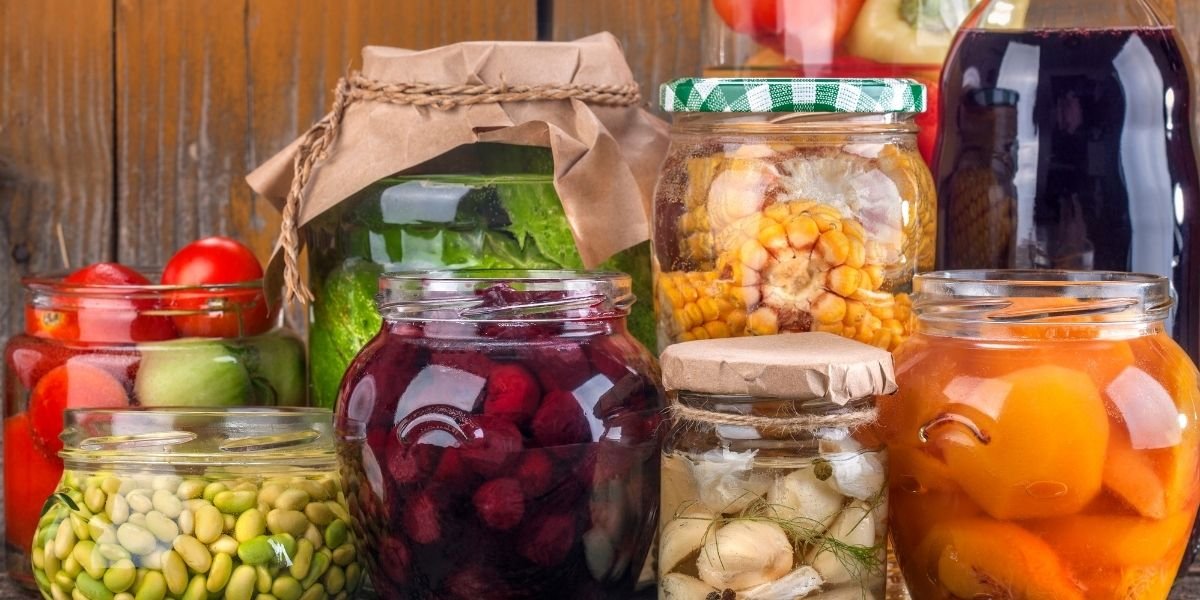Canning vs. Fermenting
The terms canning and fermenting are often used interchangeably. While they are both ways of preserving foods the end result is remarkably different.
The process of canning is a little more involved and requires more equipment. Canning is where the food in a jar is boiled long enough to kill any micro-organisms that might be living in the food. During boiling, a vacuum seal is created to prevent food from spoiling.
Fermentation on the other hand eliminates food spoilage by submerging it in a salt brine. In feremtnatiion you are growing good bacteria. The good bacteria eats up the sugar and transforms them into acids or alcohols. Fermented foods must be stored in a cool place like a fridge or root cella.
Nutritionally speaking…
Canning focuses on killing any micro-organisms or exposure to spoilage, whereas fermenting focuses on suppressing bad bacteria and encouraging good bacteria. So vegetables you have canned yourself at home are generally similar in nutritional value to fresh vegetables, the content of several vitamins is lowered significantly during heating; as well small percentages of their nutrients are lost over time. While foods preserved by fermentation, actually have increased nutritional value. They are high in beneficial bacteria making them rich in probiotics that are fantastic for our digestive and immune systems. Also the enzymes created in the fermentation process make the nutrients in the foods more bioavailable!
Time and Cost…
Canning is morel labour-intense. Producing a batch of preserved food does require more time in the kitchen. We have spent hours chopping, cooking and canning various jars of salsa, tomatoes, tomato sauce and various fruits. After all the prep work, the foods must be ladled into hot, sterilized jars, put into a boiling water bath, processed, allowed to cool and then stored.
Where as, fermenting takes less time and planning. You can also do small batches as foods come available from your garden. The food must simply be packed into sterilised jars and covered with a salt brine. All you have to do is let the jars sit at room temperature for about 3 days while the food and salt do the work for you. After the fermentation is complete, simply move to cold storage.
Canning does require equipment such as a water bath canner and a canning kit that supplies all the tools needed. Both canning and fermenting you will require mason type jars and lids. Canning you will require new lids each time to ensure they seal properly. Fermenting you do not need to buy lids ongoing. Some people like to use a weight for fermenting but there are healthful ways around this if one is not available.
As you can see, the cost of both time and equipment of both methods varies. It depends on what you are preserving and how much of it you’ll be doing. Personally I choose fermenting almost every time. I like that I can do small batches as veggies become available, I love the health benefits and more of all I love the tangy flavour. That being said there is still something about a pot of fresh salsa simmering on my stove early fall the still gets me.
If learning to ferment foods is something that you are interested that is a class that is popular every time it is offered. Stay tuned for upcoming fermentation classes coming both in-person and online this fall!
How to Preserve Food at Home
Last updated on July 28th, 2022
by Academy of Culinary Nutrition in HOW TO RESOURCES
This is a great blog about a variety of ways you can preserve foods at home. Whether it’s foods that you have gathered from your garden or bulk purchased while it season. It’s packed full of ideas.





Yummy! Homemade salsa is one of my absolute favourites to make. Every few years we make a mess in our kitchen a make a few batches of this delicious recipe. Over the years we have navigated away from the original recipe that we found online. Some flavours added by accidents. Others were conscious experimentation. Playing around and exploring different combinations makes for fun delicious salsa to be enjoyed with chips, on taco and a great addition to any salad.